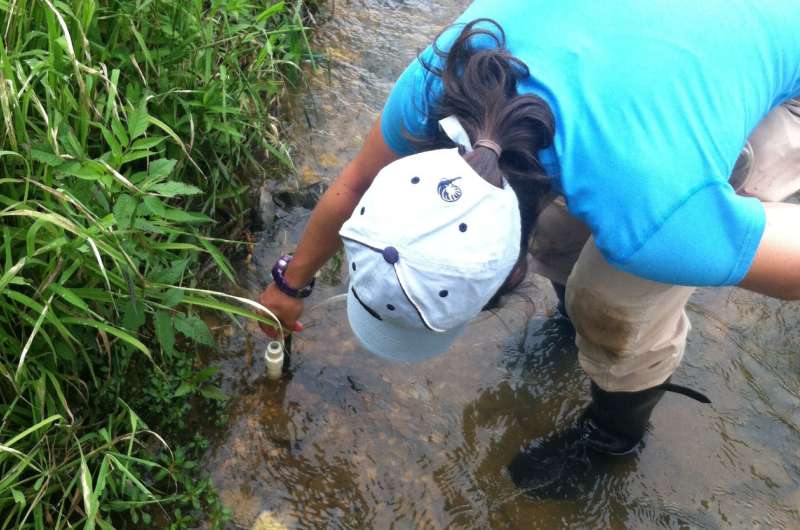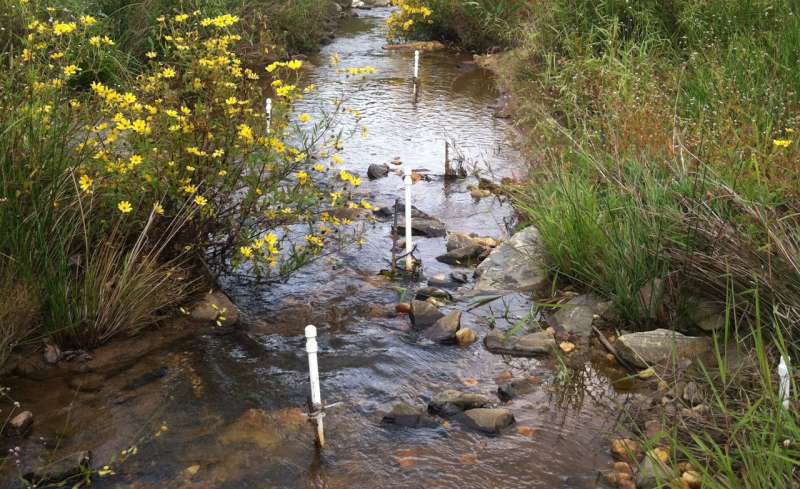Removing nitrate for healthier ecosystems

Nitrogen can present a dilemma for farmers and land managers.
On one hand, it is an essential nutrient for crops.
However, excess nitrogen in fertilizers can enter groundwater and pollute aquatic systems. This nitrogen, usually in the form of nitrate, can cause algal blooms. Microbes that decompose these algae can ultimately remove oxygen from water bodies, causing dead zones and fish kills.
In a new study, researchers have identified nitrate removal hotspots in landscapes around agricultural streams.
"Understanding where nitrate removal is highest can inform management of agricultural streams," says Molly Welsh, lead author of the study. "This information can help us improve water quality more effectively."
Welsh is a graduate student at the State University of New York College of Environmental Science and Forestry. She studied four streams in northwestern North Carolina. The streams showed a range of degradation and restoration activity. One of the streams had been restored. Two others were next to agricultural lands. The fourth site had agricultural activity in an upstream area.

The researchers analyzed water and sediment samples from the streams. They also analyzed soil samples from buffer zones next to the streams. Buffer zones are strips of land between an agricultural field and the stream. They often include native plants. Previous research showed they are particularly effective at absorbing and removing nitrate.
Welsh's research confirmed previous findings: Nitrate removal in buffer zones was significantly higher than in stream sediments. "If nitrate removal is the goal of stream restoration, it is vital that we conserve existing buffer zones and reconnect streams to buffer zones," says Welsh.
Within these buffer zones, nitrate removal hotspots occurred in low-lying areas. These hotspots had fine-textured soils, abundant soil organic matter, and lots of moisture. The same was true in streams. Nitrate removal was highest in pools where water collected for long times. These pools tended to have fine sediments and high levels of organic matter. However, pools created during stream restoration by installing channel-spanning rocks did not show high levels of nitrate removal. Creating pools using woody debris from trees may be more effective than rock structures for in-stream nitrogen removal.
The researchers also tested simple statistical models to understand which factors promote nitrate removal. Bank slope and height, vegetation and soil type, and time of year explained 40% of the buffer zone's nitrate removal. Similar to the hotspots identified in the field experiment, fine sediment textures, organic matter, and dissolved carbon content were key to removing nitrates in streams.
"Our results show that it may be possible to develop simple models to guide nitrogen management," says Welsh. "However, more work is needed in terms of gathering and evaluating data. Then we can find the best parameters to include in these models."
Welsh continues to study how stream restoration influences the movement of water and nitrate removal. She is also examining how steps to increase nitrate removal influence other aspects of landscape management.
More information: Molly K. Welsh et al, Denitrification along the Stream-Riparian Continuum in Restored and Unrestored Agricultural Streams, Journal of Environment Quality (2017). DOI: 10.2134/jeq2017.01.0006
Provided by American Society of Agronomy


















